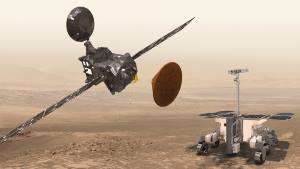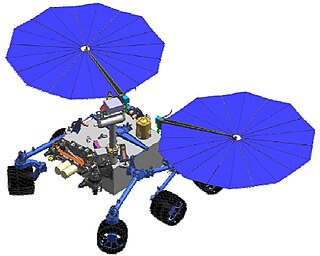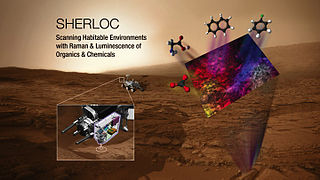Related Research Articles
A biosignature is any substance – such as an element, isotope, molecule, or phenomenon – that provides scientific evidence of past or present life on a planet. Measurable attributes of life include its complex physical or chemical structures, its use of free energy, and the production of biomass and wastes.

ExoMars is an astrobiology programme of the European Space Agency (ESA).

Mawrth Vallis is a valley on Mars, located in the Oxia Palus quadrangle at 22.3°N, 343.5°E with an elevation approximately two kilometers below datum. Situated between the southern highlands and northern lowlands, the valley is a channel formed by massive flooding which occurred in Mars’ ancient past. It is an ancient water outflow channel with light-colored clay-rich rocks.

The Mars Astrobiology Explorer-Cacher (MAX-C), also known as Mars 2018 mission, was a NASA concept for a Mars rover mission, proposed to be launched in 2018 together with the European ExoMars rover. The MAX-C rover concept was cancelled in April 2011 due to budget cuts.
Rosalind Franklin, previously known as the ExoMars rover, is a planned robotic Mars rover, part of the international ExoMars programme led by the European Space Agency and the Russian Roscosmos State Corporation. The mission was scheduled to launch in July 2020, but was postponed to 2022. The Russian invasion of Ukraine has caused an indefinite delay of the programme, as the member states of the ESA voted to suspend the joint mission with Russia; in July 2022, ESA terminated its cooperation on the project with Russia. As of May 2022, the launch of the rover is not expected to occur before 2028 due to the need for a new non-Russian landing platform.

Sample Analysis at Mars (SAM) is a suite of instruments on the Mars Science Laboratory Curiosity rover. The SAM instrument suite will analyze organics and gases from both atmospheric and solid samples. It was developed by the NASA Goddard Space Flight Center, the Laboratoire des Atmosphères Milieux Observations Spatiales (LATMOS) associated to the Laboratoire Inter-Universitaire des Systèmes Atmosphériques (LISA), and Honeybee Robotics, along with many additional external partners.
The PanCam assembly is a set of two wide angle cameras for multi-spectral stereoscopic panoramic imaging, and a high resolution camera for colour imaging that has been designed to search for textural information or shapes that can be related to the presence of microorganisms on Mars. This camera assembly is part of the science payload on board the European Space Agency'sRosalind Franklin rover, tasked to search for biosignatures and biomarkers on Mars. The rover is planned to be launched in August–October 2022 and land on Mars in spring 2023.

Icebreaker Life is a Mars lander mission concept proposed to NASA's Discovery Program. The mission involves a stationary lander that would be a near copy of the successful 2008 Phoenix and InSight spacecraft, but would carry an astrobiology scientific payload, including a drill to sample ice-cemented ground in the northern plains to conduct a search for biosignatures of current or past life on Mars.

Scanning Habitable Environments with Raman and Luminescence for Organics and Chemicals (SHERLOC) is an ultraviolet Raman spectrometer that uses fine-scale imaging and an ultraviolet (UV) laser to determine fine-scale mineralogy, and detect organic compounds designed for the Perseverance rover as part of the Mars 2020 mission. It was constructed at the Jet Propulsion Laboratory with major subsystems being delivered from Malin Space Science Systems and Los Alamos National Laboratory.
The Mars Organic Molecule Analyser (MOMA) is a mass spectrometer-based instrument on board the Rosalind Franklin rover to be launched in 2028 to Mars on an astrobiology mission. It will search for organic compounds in the collected soil samples. By characterizing the molecular structures of detected organics, MOMA can provide insights into potential molecular biosignatures. MOMA will be able to detect organic molecules at concentrations as low as 10 parts-per-billion by weight (ppbw). MOMA examines solid crushed samples exclusively; it does not perform atmospheric analyses.

The Urey instrument, or Urey: Mars Organic and Oxidant Detector was a developmental spacecraft instrument for detecting organic compounds including amino acids.

SuperCam is a suite of remote-sensing instruments for the Mars 2020 Perseverance rover mission that performs remote analyses of rocks and soils with a camera, two lasers and four spectrometers to seek organic compounds that could hold biosignatures of past microbial life on Mars, if it ever existed there.
Mars Multispectral Imager for Subsurface Studies (Ma_MISS) is a miniaturized imaging spectrometer designed to provide imaging and spectra by reflectance in the near-infrared (NIR) wavelength region and determine the mineral composition and stratigraphy. The instrument is part of the science payload on board the European Rosalind Franklin rover, tasked to search for biosignatures, and scheduled to launch not earlier than 2028. Ma_MISS is essentially inside a drill on the Rover, and will take measurements of the sub-surface directly.

MicrOmega-IR is an infrared hyperspectral microscope that is part of the science payload on board the European Rosalind Franklin rover, tasked to search for biosignatures on Mars. The rover is planned to be launched not earlier than 2028. MicrOmega-IR will analyse in situ the powder material derived from crushed samples collected by the rover's core drill.
Infrared Spectrometer for ExoMars (ISEM) is an infrared spectrometer for remote sensing that is part of the science payload on board the European Space Agency'sRosalind Franklin rover, tasked to search for biosignatures and biomarkers on Mars. The rover is planned to be launched not earlier than 2028 and land on Mars in 2029.
ADRON-RM is a neutron spectrometer to search for subsurface water ice and hydrated minerals. This analyser is part of the science payload on board the European Space Agency'sRosalind Franklin rover, tasked to search for biosignatures and biomarkers on Mars. The rover is planned to be launched not earlier than 2028 and land on Mars in 2029.
WISDOM is a ground-penetrating radar that is part of the science payload on board the European Space Agency'sRosalind Franklin rover, tasked to search for biosignatures and biomarkers on Mars. The rover is planned to be launched not earlier than 2028 and land on Mars in 2029.
CLUPI is a miniaturized camera system on board the planned European Space Agency Rosalind Franklin rover. CLUPI has been designed to acquire high-resolution close-up images in colour of soils, outcrops, rocks, drill fines and drill core samples, as well as and the search for potential biosignature structures and patterns. This camera assembly is part of the science payload on board the European Space Agency'sRosalind Franklin rover, tasked to search for biosignatures and biomarkers on Mars. The rover is planned to be launched not earlier than 2028 and land on Mars in 2029.
Spanish Astrobiology Center is a state-run institute in Spain dedicated to astrobiology research, and it is part of the National Institute of Aerospace Technology (INTA) as well as the Spanish National Research Council (CSIC). It was created in 1999 and it is affiliated with NASA Astrobiology Institute.
Signs Of LIfe Detector (SOLID) is an analytical instrument under development to detect extraterrestrial life in the form of organic biosignatures obtained from a core drill during planetary exploration.
References
- ↑ Vago, Jorge L.; et al. (July 2017). "Habitability on Early Mars and the Search for Biosignatures with the ExoMars Rover". Astrobiology. 17 (6–7): 471–510. Bibcode:2017AsBio..17..471V. doi:10.1089/ast.2016.1533. PMC 5685153 . PMID 31067287.
- ↑ Howell, Elizabeth (July 24, 2018). "ExoMars: Searching for Life on Mars". Space.com . Retrieved March 13, 2020.
- 1 2 3 4 5 6 7 "The ExoMars Rover Instrument Suite: RLS - Raman Spectrometer". European Space Agency. 3 April 2013.
- ↑ Popp, J.; Schmitt, M. (2006). "Raman spectroscopy breaking terrestrial barriers!". Journal of Raman Spectroscopy. 35 (6): 18–21. Bibcode:2004JRSp...35..429P. doi:10.1002/jrs.1198.
- ↑ Rull Pérez, Fernando; Martinez-Frias, Jesus (2006). "Raman spectroscopy goes to Mars" (PDF). Spectroscopy Europe. 18 (1): 18–21.
- 1 2 3 4 5 6 7 8 The Raman Laser Spectrometer for the ExoMars Rover Mission to Mars. Fernando Rull, Sylvestre Maurice, Ian Hutchinson, Andoni Moral, Carlos Perez, Carlos Diaz, Maria Colombo, Tomas Belenguer, Guillermo Lopez-Reyes, Antonio Sansano, Olivier Forni, Yann Parot, Nicolas Striebig, Simon Woodward, Chris Howe, Nicolau Tarcea, Pablo Rodriguez, Laura Seoane, Amaia Santiago, Jose A. Rodriguez-Prieto, Jesús Medina, Paloma Gallego, Rosario Canchal, Pilar Santamaría, Gonzalo Ramos, Jorge L. Vago, and on behalf of the RLS Team. Astrobiology, 1 July 2017, 17(6-7), pages 627-654. doi : 10.1089/ast.2016.1567
- 1 2 Raman Laser pectrometer for 2020 ExoMars Mission. Engineering and qualification model capabilities and future activities. (PDF). A. G. Morala, F. Rull, S. Maurice, I. Hutchinson, C.P. Canora, L. Seoane, R. Canchal, P. Gallego, G. Ramos, J.A.R. Prieto, A. Santiago, P. Santamaría, M. Colombo, T. Belenguer, G. López, C. Quintana, J. Zafra, A. Berrocal, C. Pintor, J. Cabrero, J. Saiz. 49th Lunar and Planetary Science Conference 2018. LPI Contrib. No. 2083.
- ↑ "The ExoMars Rover Instrument Suite". exploration.esa.int. Retrieved 2018-07-22.
- ↑ THE RAMAN LASER SPECTROMETER (RLS) ON THE EXOMARS 2018 ROVER MISSION (PDF). 42nd Lunar and Planetary Science Conference (2011). Retrieved July 14, 2024.
- 1 2 The search for signatures of early life on Mars: Raman spectroscopy and the Exomars mission. Howell G.M. Edwards, Ian B. Hutchinson, Richard Ingley, Nick R. Waltham, Sarah Beardsley, Shaun Dowson, and Simon Woodward. Spectroscopy Europe.
